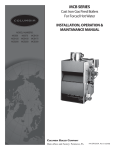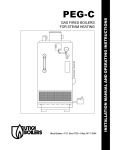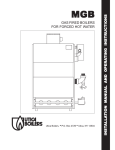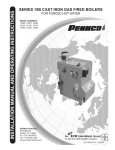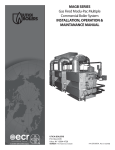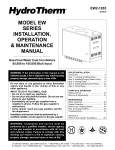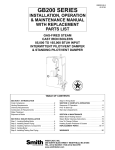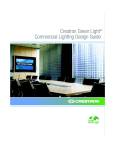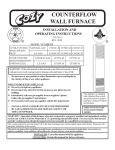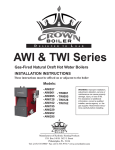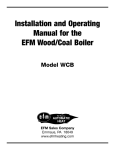Download Columbia MCB-150J Operating instructions
Transcript
MCB SERIES Cast Iron Gas Fired Boilers For Forced Hot Water MODEL NUMBERS: MCB50 MCB75 MCB100 MCB125 MCB150 MCB175 MCB200 MCB250 MCB300 INSTALLATION, OPERATION & MAINTENANCE MANUAL Columbia Company Main offices and Factory: Pottstown, PA P/N 37612101, Rev. E [05/2012] INSTALLATION, OPERATION AND MAINTENANCE MANUAL KEEP THIS MANUAL NEAR BOILER RETAIN FOR FUTURE REFERENCE Ratings & Data - Natural Gas & Propane Gas............ 3 Dimensions..........................................................4 Installation Procedure...........................................5 IMPORTANT: Read the following instructions COMPLETELY before installing!! Ventilation & Combustion Air.................................. 6 Connecting Supply and Return Piping...................... 7 Connecting Supply and Return Piping...................... 8 WARNING Vent Installation................................................. 12 Keep boiler area clear and free from combustible materials, gasoline and other flammable vapors and liquids. Vent System Modification..................................... 12 Vent Damper Installation & Instructions................. 13 DO NOT obstruct air openings to the boiler room. Connecting Gas Service....................................... 14 Electrical Section................................................ 15 Wiring Diagram - 24V Standing Pilot..................... 16 Wiring Diagram - Intermittent Ignition.................. 17 ! Lighting Instructions........................................... 18 Normal Sequence of Operation............................. 20 TO THE OWNER - Installation and service of this boiler must be performed by a qualified installer. General Instructions........................................... 20 Checking Gas Input Rate To Boiler........................ 22 TO THE INSTALLER - Leave all instructions with the boiler for future reference. Replacement Parts - Base.................................... 23 Safety Symbols & Warnings The following defined symbols are used throughout this manual to notify the reader of potential hazards of varying risk levels. When this product is installed in the Commonwealth of Massachusetts the installation must be performed by a Licensed Plumber or Licensed Gas Fitter. DANGER ! Indicates a hazardous situation which, if not avoided, WILL result in death or serious injury. WARNING WARNING ! ! Indicates a hazardous situation which, if not avoided, could result in death or serious injury. CAUTION ! Modification, substitution or elimination of factory equipped, supplied or specified components may result in property damage, personal injury or the loss of life. Indicates a hazardous situation which, if not avoided, may result in minor or moderate injury. All installations of boilers and venting shall be done only by a qualified expert and in accordance with appropriate manual. Installing or venting a boiler or any other gas appliance with improper methods or materials may result in serious injury or death due to fire or to asphyxiation from poisonous gases such as carbon monoxide which is odorless and invisible. H NOTICE Indicates information which should be followed to ensure proper installation and operation. C.S.A. Certified For Natural Gas Or Propane 2 Tested For 100 psi. ASME Working Pressure RATINGS & DATA - NATURAL GAS & PROPANE GAS Table 1 - Ratings and Capacities Boiler No. (1) (1) Input Mbh Heating Capacity Mbh (2) ** Net Rating Water Mbh No. of Burners Recommended Air Cushion Tank Water Content (Gals.) High Altitude Input 1 15 2.4 45,000 (3) 50 50 42 37 75 75 63 55 2 15 4.0 67,500 100 100 83 72 2 30 4.0 90,000 125 125 104 90 3 30 5.6 112,500 150 150 124 108 3 30 5.6 135,000 175 175 143 124 4 30 7.2 157,000 200 200 165 143 4 30 7.2 180,000 250 250 205 178 5 30 8.8 225,000 300 299 243 214 6 60 10.4 270,000 EXPLANATORY NOTES -- All boilers are design certified for installation on noncombustible floor. -- For installation on combustible floors use combustible floor kit. -- Recommended chimney height 20 feet. In special cases where conditions permit, chimney height may be reduced to 10 feet. Refer to the latest revision of NFGC part 11. -- Electric service to be 120 Volts, 15 Amps, 60 Hz. -- The MEA number for the this boiler is 19-79-E. (1) Input rating for sea level to 2,000 ft. (610m) above sea level. • United States, over 2000 ft (610m) above sea level. Reduce input rate 4% for every 1000 ft (304m) above sea level. • Canada, 2000 ft (610m) to 4500 (1350m) above sea level. Reduce input per table. • Canada, over 4500 ft (1350m) above sea level. Contact Provincial authority having jurisdiction. (2) Net Water Ratings shown based on piping and pickup allowance of 1.15. Consult manufacturer before selecting boiler for installations having unusual piping and pickup requirements, such as intermittent system operation, extensive piping systems, etc. For forced hot water systems where boiler and all piping within area to be heated, boiler may be selected on basis of its heating capacity. (3) Tank sized for non-ferrous baseboard or radiant panel systems. Increase size for cast iron baseboard and radiation. STANDARD EQUIPMENT: Boiler Jacket, Cast Iron Boiler Battery, High Limit Control, Vent Damper Relay, Theraltimeter Gauge, Circulator With Return Piping To Boiler, Main Gas Burners, Combination 24 Volt Gas Control (Includes Automatic Gas Valve, Gas Pressure Regulator, Automatic Pilot, Safety Shutoff, Pilot Flow Adjustment, Pilot Filter), A.S.M.E. Relief Valve, Drain Valve, Spill Switch, Rollout Switch, Automatic Vent Damper. Not Shown Are: Wiring Harness, Thermocouple, Non-linting Safety Pilot. OPTIONAL EQUIPMENT: Intermittent Electric Ignition Pilot System. 3 DIMENSIONS Table 2 - Dimensions Dimensions Boiler No. Natural Gas Inlet* A B C D E F Pump size Supply & Return Tappings 50 ½" 11⅛" 5½" 4" 30¾" 36¼" 6" 1¼" 75 ½" 15 7½" 5" 30¾" 37¾" 6" 1¼" 100 ½" 15 7½" 6" 30¾" 37¼" 6½" 1¼" 125 ½" 18⅞" 9½" 6" 30¾" 37¼" 6½" 1¼" 150 ½" 18⅞" 9½" 7" 30¾" 37¾" 7" 1¼" 175 ½" 22¾" 11½" 7" 30¾" 38¾" 7" 1¼" 200 ½" 22¾" 11½" 8" 30¾" 38¾" 8" 1¼" 250 ¾" 13 13¼" 8" 30¾" 40¾" 8" 1¼" 300 ¾" 15¼" 9" 30¾" 42¾" 10" 1¼" 26 ⁄16" 30½" * Propane gas inlet, all units, 1/2" 4 INSTALLATION PROCEDURE 9. FOR INSTALLATION ON NON-COMBUSTIBLE WARNING ! FLOORS ONLY - For installation on combustible flooring special base must be used. (See Replacement Parts Section.) Boiler can not be installed on carpeting. Minimum clearances to combustible construction are: Improper installation, adjustment, alteration, service or maintenance can cause injury or property damage. 1. Installation must conform to the requirements of the 2. 3. 4. 5. 6. 7. 8. TOP.....................................18 IN. (457mm) FRONT..........................................ALCOVE * FLUE CONNECTOR����������������� 6 IN. (152mm) REAR.................................... 4 IN. (102mm) CONTROL SIDE...................... 9 IN. (229mm) OTHER SIDE............................ 3 IN. (76mm) HOT WATER PIPING�������������� 1/2 IN. (13mm) authority having jurisdiction or, in the absence of such requirements, to the National Fuel Gas Code, ANSI Z223.1/NFPA 54, and/or Natural Gas and Propane Installation Code, CAN/CSA B149.1. Where required by the authority having jurisdiction, the installation must conform to the Standard for Controls and Safety Devices for Automatically fired Boilers, ANSI/ASME CSD-1. This boiler series is classified as a Category I. Vent installation shall be in accordance with "Venting of Equipment ," of the National Fuel Gas Code, ANSI Z223.1/NFPA 54, or "Venting Systems and Air Supply for Appliances," of the Natural Gas and Propane Installation Code, CAN/CSA B149.1, or applicable provisions of the local building codes. This boiler has met safe lighting and other performance criteria with gas manifold and control assembly on the boiler per the latest revision of ANSI Z21.13/CGA 4.9. The boiler shall be installed such that the gas ignition system components are protected from water (dripping, spraying, rain, etc.) during appliance operation and service, (circulator replacement, condensate trap, control replacement, etc.). Locate boiler on level, solid base as near the chimney as possible and centrally located with respect to the heat distribution system as practical. Allow 24 inches (610mm) at front and right side for servicing and cleaning. When installed in utility room, door should be wide enough to allow largest boiler part to enter, or to permit replacement of another appliance such as water heater. NOTE: Greater clearances for access should supersede fire protection clearances. * Definition of Alcove is three sided space with no wall in front of boiler. ANSI standard for alcove is 18 inches from front of appliance to leading edge of side walls as shown below. Minimum Clearances to Combustible Construction (as seen from above) 4" 9" BOILER 18" 5 3" VENTILATION & COMBUSTION AIR Provide combustion air and ventilation air in accordance with the section “Air for Combustion and Ventilation,” of the National Fuel Gas Code, ANSI Z223.1/NFPA 54, or Sections 8.2, 8.3 or 8.4 of Natural Gas and Propane Installation Code, CAN/CSA B149.1, or applicable provisions of local building codes. •All Outdoor Air. Provide permanent opening(s) communicating directly or by ducts with outdoors. оо Two Permanent Opening Method. Provide opening commencing within 12 inches of top and second opening commencing within 12 inches of bottom enclosure. Provide make-up air where exhaust fans, clothes dryers, and kitchen ventilation equipment interfere with proper operation. Direct communication with outdoors or communicating through vertical ducts. Provide minimum free area of 1 in2 per 4 Mbh of total input rating of all appliances in enclosure. National Fuel Gas Code recognizes several methods of obtaining adequate ventilation and combustion air. Requirements of the authority having jurisdiction may override these methods. •Engineered Installations. Must be approved by authority having jurisdictions. Communicating through horizontal ducts. Provide minimum free area of 1 in2 per 2 Mbh of total input rating of all appliances in enclosure. оо One Permanent Opening Method. Provide opening commencing within 12 inches of top of enclosure. Provide minimum clearance of 1 inch on sides and back and 6 inches on front of boiler (does not supersede clearance to combustible materials). •Mechanical Air Supply. Provide minimum of 0.35 cfm per Mbh for all appliances located within space. Additional requirements where exhaust fans installed. Interlock each appliance to mechanical air supply system to prevent main burner operation when mechanical air supply system not operating. оо Combination Indoor and Outdoor Air. Refer to National Fuel Gas Code for additional requirements for louvers, grilles, screens and air ducts. •All Indoor Air. Calculate minimum volume for all appliances in space. Use a different method if minimum volume not available. •Combination Indoor and Outdoor Air. Refer to National Fuel Gas Code for application information. National Gas and Propane Installation Code Requires providing air supply in accordance with: •Section 8.2 and 8.3 when combination of appliances has a total input of up to and including 400 Mbh (120 kW). оо Standard Method. Cannot be used if known air infiltration rate is less than 0.40 air changes per hour. See Table 3 for space with boiler only. Use equation for multiple appliances. Volume ≥ 50 ft3 x Total Input [Mbh] оо Known Air Infiltration Rate. See Table 3 for space with boiler only. Use equation for multiple appliances. Do not use an air infiltration rate (ACH) greater than 0.60. •Section 8.4 when combination of appliances has total input exceeding 400 Mbh (120 kW). •Refer to Natural Gas and Propane Installation Code for specific air supply requirements for enclosure or structure where boiler is installed, including air supply openings and ducts. Volume ≥ 21 ft3/ACH x Total Input [Mbh] оо Refer to National Fuel Gas Code for opening requirements between connection indoor spaces. Table 3 Known Air Infiltration Rate Method (Air Changes Per Hour) Input Mbh Standard Method 0.1 0.2 0.3 0.4 0.5 0.6 50 2500 10500 5250 3500 2625 2100 1750 75 3750 15750 7875 5250 3938 3150 2625 100 5000 21000 10500 7000 5250 4200 3500 125 6250 26250 13125 8750 6563 5250 4375 150 7500 31500 15750 10500 7875 6300 5250 175 8750 36750 18375 12250 9188 7350 6125 200 10000 42000 21000 14000 10500 8400 7000 250 12500 52500 26250 17500 13125 10500 8750 300 15000 63000 31500 21000 15750 12600 10500 6 CONNECTING SUPPLY AND RETURN PIPING WARNING To avoid burns, scalding, or water damage due to discharge of steam and/or hot water during operation, a discharge line shall be installed to relief valve outlet connection. Discharge line shall: •connect to relief valve outlet and piped down to safe point of disposal. Check local codes for maximum distance from floor or allowable safe point of discharge. •be of pipe size equal to or greater than that of the relief valve outlet over the entire length of discharge line; •have no intervening shutoff valve between safety relief valve and discharge to atmosphere (do not plug or place any obstruction in discharge line. •terminate freely to atmosphere where any discharge will be clearly visible and at no risk of freezing; •allow complete drainage of the valve and the discharge line; •be independently supported and securely anchored to avoid applied stress on the relief valve; •be as short and straight as possible; •terminate with plain end (not threaded); •be constructed of material suitable for exposure to temperatures of 375° F; or greater. Refer to local codes and appropriate ASME Boiler and Pressure Vessel Code for additional installation requirements. RELIEF VALVE RELIEF VALVE DISCHARGE LINE DISCHARGE LINE Check local codes for maximum distance from floor or allowable safe point of discharge. Check local codes for maximum distance from floor or allowable safe point of discharge. 7 CONNECTING SUPPLY AND RETURN PIPING IMPORTANT: Circulators in the following illustrations are mounted on the system supply side, but mounting on the system return side is also acceptable practice. Figure 5 - Circulators Mounted on System Supply AIR SEPARATOR 1. The boiler, when used in connection with a refrigeration 2. 3. 4. 5. 6. Bypass piping is an option which gives the ability to system, must be installed so the chilled medium is piped in parallel with the boiler with appropriate valves to prevent the chilled medium from entering the boiler. See Figure 5. The boiler piping system of a hot water boiler connected to heating coils located in air handling units where they may be exposed to refrigerated air circulation must be equipped with flow control valves or other automatic means to prevent gravity circulation of the boiler water during the cooling cycle. Hot water boilers installed above radiation level or as required by authority having jurisdiction must be provided with a low water cut-off device. When a boiler is connected to a heating system that utilizes multiple zoned circulators, each circulator must be supplied with a flow control valve to prevent gravity circulation. Hot water boilers and system must be filled with water and maintained to a minimum pressure of 12 psi. adjust the supply boiler water temperature to fit the system or the condition of the installation. This method of piping, however, is not typically required for baseboard heating systems. Typical installations where bypass piping is used are as follows: A. This method is used to protect boilers from condensation forming due to low temperature return water. Generally noticed in large converted gravity systems or other large water volume systems. Figure 6 & 7. B. These methods are used to protect systems using radiant panels and the material they are encased in from high temperature supply water from the boiler and protect the boiler from condensation. NOTE#1: When using bypass piping, adjust valves V1 & V2 until desired system temperature is obtained. NOTE#2: Bypass loop must be same size piping as the supply and return piping. 8 CONNECTING SUPPLY AND RETURN PIPING Figure 6 - Bypass Piping Automatic Mixing Valve FROM SYSTEM TO SYSTEM WATER INLET EXPANSION TANK BOILER ALTERNATE CIRCULATOR LOCATION CIRCULATOR PRESSURE REDUCER VALVE BALL VALVE AIR SEPARATOR SHUT-OFF VALVE CHECK VALVE 3 WAY MIXING VALVE HOSE BIB Figure 7 - Bypass Piping - Fixed Low Temp Only Automatic Mixing Valve FROM SYSTEM TO SYSTEM V1 V2 SYSTEM CIRCULATOR WATER INLET EXPANSION TANK BOILER ALTERNATE CIRCULATOR LOCATION CIRCULATOR PRESSURE REDUCER VALVE BALL VALVE SHUT-OFF VALVE CHECK VALVE ZONE VALVE 7. Installation using circulators and zone valves are AIR SEPARATOR • Individual boiler discharge piping shall be independent of other discharge piping. shown in Figures 8-11. For further piping information refer to I=B=R Installation and Piping Guide. •Size and arrange discharge piping to avoid reducing safety relief valve relieving capacity below minimum relief valve capacity stated on rating plate. ! WARNING •Run pipe as short and straight as possible to location protecting user from scalding and properly drain piping. Burn and scald hazard. Safety relief valve could discharge steam or hot water during operation. Install discharge piping per these instructions. • Install union, if used, close to safety relief valve outlet. 8. Install discharge piping from safety relief valve. •Install elbow(s), if used, close to safety relief valve outlet and downstream of union (if used). •Use ¾" or larger pipe. •Use pipe suitable for temperatures of 375°F (191°C) or greater. •Terminate pipe with plain end (not threaded). 9 CONNECTING SUPPLY AND RETURN PIPING Figure 8 - Single Zone System With DHW Priority Figure 9 - Multi Zone System With Circulators And DHW Priority 10 CONNECTING SUPPLY AND RETURN PIPING Figure 10 - Multi Zone System With Zone Valves And DHW Priority (With Circulator) Figure 11 - Multi Zone System With Zone Valves And Dhw Priority (With Zone Valve) 11 VENT INSTALLATION 3. This boiler series is classified as a Category I. Vent WARNING ! installation shall be in accordance with "Venting of Equipment," of the National Fuel Gas Code, ANSI Z223.1/NFPA 54, or "Venting Systems and Air Supply for Appliances," of the Natural Gas and Propane Installation Code, CAN/CSA B149.1, or applicable provisions of the local building codes. All installations of boilers and venting should be done only by a qualified expert and in accordance with the appropriate manual. Installing or venting a boiler or any other gas appliance with improper methods or materials may result in serious injury or death due to fire or to asphyxiation from poisonous gases such as carbon monoxide with is odorless and invisible. 4. Inspect chimney to make certain it is constructed according to NFPA 211. The vent or vent connector shall be Type B or metal pipe having resistance to heat and corrosion not less than that of galvanized sheet steel or aluminum not less than 0.016 inch thick (No. 28 Ga). WARNING ! 5. Connect flue pipe from draft hood to chimney. Bolt or screw joints together to avoid sags. Flue pipe should not extend beyond inside wall of chimney. Do not install manual damper in flue pipe or reduce size of flue outlet except as provided by the latest revision of ANSI Z223.13 or CAN/CSA B149.1. Protect combustible ceiling and walls near flue pipe with fireproof insulation. Where two or more appliances vent into a common flue, the area of the common flue must be at least equal to the area of the largest flue plus 50 percent of the area of each additional flue. This boiler shall not be connected to any portion of a mechanical draft system operating under positive pressure. 1. The vent pipe must slope upward from the boiler not less then ¼ inch for every 1 foot (21mm/m) to vent terminal. 2. Horizontal portions of the venting system shall be supported rigidly every 5 feet and at the elbows. No portion of the vent pipe should have any dips or sags. VENT SYSTEM MODIFICATION When an existing boiler is removed from a common venting system, the system is likely to be too large for the proper venting of the appliances sill connected to it. If this situation occurs, the following test procedure must be followed: REMOVAL OF BOILER FROM VENTING SYSTEM At the time of removal of an existing boiler, the following steps shall be followed with each appliance remaining connected to the common venting system placed in operation, while the other appliances remaining connected to the common venting system are not in operation. 1. Seal an unused opening in the common venting system. 2. Visually inspect the venting system for proper size and horizontal pitch and determine there is no blockage or restriction, leakage, corrosion and other deficiencies which could cause an unsafe condition. 3. Insofar as is practical, close all building doors and windows and all doors between the space in which the appliances remaining connected to the common venting system are located and other spaces of the building. Turn on clothes dryers and any other appliance not connected to the common venting system. Turn on any exhaust fans, such as range hoods and bathroom exhausts, so they operate at maximum speed. Do not operate a summer exhaust fan. Close fireplace dampers. 4. Place in operation the appliance being inspected. Follow the lighting instructions. Adjust thermostat so appliance will operate continuously. 5. Test for spillage at the draft hood relief opening after 5 minutes of main burner operation. Use the flame of a match or candle, or smoke from a cigarette, cigar or pipe. 6. After it has been determined that each appliance remaining connected to a common venting system properly vents when tested as outlined above, return doors, windows, exhaust fans, fireplace dampers and any other gas burning appliances to their previous condition of use. 7. Any improper operation of the common venting system should be corrected so the installation conforms with the National Fuel gas Code, ANSI Z223.1/NFPA 54, and/or the Natural Gas and Propane Installation Code, CAN/CSA B149.1. When re-sizing any portion of the common venting system, the common venting system should be re-sized to approach the minimum size determined using the appropriate tables in Chapter 13 of the National Fuel Gas Code, ANSI Z223.1/NFPA 54, and/or the Natural Gas and Propane Installation Code, CAN/CSA B149.1. 12 VENT DAMPER INSTALLATION & INSTRUCTIONS DAMPER INSTALLATION NOTE: Refer to Figure 11 for steps 1-6. DAMPER INSTRUCTIONS Figure 12 - Damper Motor Wiring Figure 13 - Vent Damper Placement 1. Place Vent Damper on or as close to vent outlet of 1. Verify only boiler is serviced by Vent Damper. Figure 2. 3. 2. 4. 5. 6. boiler as possible. Figure 13. Remove Vent Damper Motor cover. Feed damper wire harness connector through bracket hole on Damper Motor frame. Tighten locknut onto Damper wire harness connector. Plug Damper connector into socket on Damper Motor frame. Replace Damper Motor cover and wire Damper in accordance with Figure 12. 3. 4. 5. 13 13. Clearance of not less than 6 inches (152mm) between Vent Damper and combustible material must be maintained. Additional clearance should be allowed for service of Vent Damper. Vent Damper must be in the open position when appliance main burners are operating. The Vent Damper position indicator must be in a visible location following installation. The thermostat's heat anticipator must be adjusted to match the total current draw of all controls associated with the boiler during a heating cycle. CONNECTING GAS SERVICE General CAUTION •Use piping materials and joining methods acceptable to authority having jurisdiction. In absence of such requirements: •USA - National Fuel gas Code, ANSI Z223.1/NFPA 54 •Canada - Natural Gas and Propane Installation Code, CAN/CSA B149.1 •Size and install gas piping system to provide sufficient gas supply to meet maximum input at not less than minimum supply pressure. See Table 5. •Support piping with hooks straps, bands, brackets, hangers, or building structure components to prevent or dampen excessive vibrations and prevent strain on gas connection. Boiler will not support piping weight. • Use thread (joint) compound (pipe dope) suitable for liquefied petroleum gas. •Install field sourced manual main shutoff valve, ground joint union, and sediment trap upstream of gas valve. See Figure 14. WHAT TO DO IF YOU SMELL GAS •Do not try to light any appliance. •Do not touch any electrical switch; do not use any phones in your building. ! •Immediately call your gas supplier from a neighbor’s phone. Follow gas supplier’s instructions. •If you cannot reach your gas supplier, call the fire department. Figure 14 - Gas Piping Table 5 Natural Gas Propane Min. Supply Pressure 5" w.c. 11" w.c. Max. Supply Pressure 13.5" w.c. 13.5" w.c. Manifold Pressure 3.5" w.c. 10.5" w.c. DANGER ! Leak Check Gas Piping Pressure test boiler and gas connection before placing boiler in operation. •Pressure test over 1/2 psig (3.5 kPa). Disconnect boiler and its individual gas shutoff valve from gas supply system. MAXIMUM CAPACITY OF PIPE IN CUBIC FEET OF GAS/HOUR (Gas Pressure = 0.5 psig or less, Pressure Drop = 5 in. w/c) Table 4 •Pressure test at 1/2 psig (3.5 kPa) or less. Isolate boiler from gas supply system by closing manual gas shutoff valve. Nominal Iron Pipe Size Length of Pipe (Feet) ½” ¾” 1” 1¼” 10 175 360 680 1400 20 120 250 465 950 30 97 200 375 770 40 82 170 320 660 60 66 138 260 530 80 57 118 220 460 100 50 103 195 400 Fire Hazard. Do not use matches, candles, open flames, or other methods providing ignition source. Failure to comply will result in death or serious injury. •Locate leakage using gas detector, noncorrosive detection fluid, or other leak detection method acceptable to authority having jurisdiction. Do not use matches, candles, open flames, or other methods providing ignition source. •Correct leaks immediately and retest. For additional information refer to the National Fuel Gas Code Handbook. 14 ELECTRICAL SECTION WARNING ! Electrical shock hazard. Turn OFF electrical power supply at service panel before making electrical connections. Failure to do so could result in death or serious injury. ELECTRICAL WIRING See wiring diagrams on the following two pages for details. Electrically bond boiler to ground in accordance with requirements of authority having jurisdiction. Refer to: •USA- National Electrical Code, ANSI/NFPA 70. •Canada - Canadian Electrical Code, Part I, CSA C22.1: Safety Standard for Electrical Installations. THERMOSTAT INSTALLATION 1. Thermostat should be installed on an inside wall about four feet above the floor. 2. NEVER install a thermostat on an outside wall. 3. Do not install a thermostat where it will be affected by drafts, hot or cold pipes, sunlight, lighting fixtures, televisions, a fireplace, or a chimney. 4. Check thermostat operation by raising and lowering thermostat setting as required to start and stop the burners. 5. Instructions for the final adjustment of the thermostat are packaged with the thermostat (adjusting heating anticipator, calibration, etc.) 15 WIRING DIAGRAM - 24V STANDING PILOT VR8200 OR VR8300 16 WIRING DIAGRAM - INTERMITTENT IGNITION 17 LIGHTING INSTRUCTIONS D. Do not use this appliance if any part has been under water. Immediately call a qualified service technician to inspect appliance and to replace any part of control system and any gas control which has been under water. WARNING ! If you do not follow these instructions exactly, a fire or explosion may result, causing property damage, personal injury or loss of life. Before any procedures are attempted on this appliance, determine if ignition system is electric or standing pilot. If you are uncertain, contact manufacturer before proceeding. OPERATING INSTRUCTIONS FOR INTERMITTENT PILOT SYSTEM 1. 2. 3. 4. WARNING ! Before lighting any type of pilot burner (standing or intermittent), make certain the hot water boiler and system are full of water to minimum pressure of 12 psi in the system, and also verify system is vented of air. Set operating control of thermostat to “below” normal setting. Refer to following appropriate lighting instruction. STOP! Read the safety information to the left. Set the thermostat to lowest setting. Turn off all electric power to the appliance. This appliance is equipped with an ignition device which automatically lights the pilot. Do not try to light the pilot by hand. Figure 15 - Intermittent Pilot LIGHTING PROCEDURE FOR BOILER WITH INTERMITTENT PILOT SYSTEM For Your Safety, Read Before Operating!! A. This appliance is equipped with an ignition device which automatically lights the pilot. Do not try to light the appliance by hand. 5. Turn gas control knob clockwise to “OFF.” 6. Wait (5) minutes to clear out any gas. If you then smell B. Before operating, smell all around the appliance area for gas. Be sure to smell next to the floor because some gas is heavier than air and will settle on the floor. gas, STOP! Follow “What To Do If You Smell Gas” in the safety information to the left. If you don’t smell gas, go on to the next step. CAUTION ! WHAT TO DO IF YOU SMELL GAS • Do not try to light any appliance. • Do not touch any electrical switch; do not use any phone in your building. • Immediately call your gas supplier from a neighbor’s phone. Follow the gas supplier's instructions. • If you cannot reach your gas supplier, call the fire department. 7. Turn gas control knob counterclockwise to “ON.” 8. Turn on all electric power to the appliance. 9. Set thermostat to desired setting. 10. If the appliance will not operate, follow the instructions “To Turn Off Gas To Appliance” on next page, and call a qualified service technician or your gas supplier. C. Use only your hand to push in or turn the gas control knob. Never use tools. If the knob will not push in or turn by hand, don’t try to repair it. Call a qualified service technician. Force or attempted repair may result in a fire or explosion. 18 LIGHTING INSTRUCTIONS LIGHTING PROCEDURE FOR BOILER WITH CONTINUOUS PILOT Figure 17 - Continuous Pilot For Your Safety, Read Before Lighting!! 1. Read the warning at the beginning of "Lighting Instructions." 2. This appliance has a pilot which must be lighted by hand. When lighting the pilot, follow these instructions exactly. 3. Before lighting, smell all around the appliance area for gas. Be sure to smell next to the floor because some gas is heavier than air and will settle on the floor. See section "What To Do If You Smell Gas" on previous page NOTE: Some gas control knobs cannot be turned from "PILOT" to "OFF" unless knob is pushed in slightly. DO NOT FORCE. 6. Wait (5) minutes to clear out any gas. If you then smell gas, STOP! Follow "What To Do If You Smell Gas" on previous page. If you don't smell gas, go to the next step. 7. Find pilot. Follow metal tube from gas control. Depending on the model of the boiler, pilot is either mounted on the base or on one of the burner tubes. 4. Use only your hand to push in or turn gas control knob or reset button. Never use tools. If the knob or reset button will not push in or turn by hand, don’t try to repair it, call a qualified service technician. Force or attempted repair may result in a fire or explosion. 5. Do not use this appliance if any part has been under water. Immediately call a qualified service technician to inspect the appliance and to replace any part of the control system and any gas control which has been under water. 8. Turn gas control knob counterclockwise to "PILOT." 9. Push in gas control knob or reset button if so equipped, all the way in and hold. Immediately light the pilot with a match. Continue to hold the gas control knob or reset button in for about 1 minute after the pilot is lit. Release knob or button, and it will pop up back up. Pilot should remain lit. If it goes out, repeat steps 5 through 9. •If knob or button does not pop up when released, stop and immediately call a qualified service technician or your gas supplier. LIGHTING INSTRUCTIONS FOR CONTINUOUS PILOT 1. STOP! Read the safety information above. 2. Set the thermostat to the lowest setting. 3. Turn off all electric power to the appliance. 4. Remove access panel and burner door. 5. Turn gas control knob clockwise (Figures 16 and 17) to "OFF." •If the pilot will not stay lit after several tries, turn Figure 16 - Gas Control Knob the gas control knob clockwise to "OFF." Call a qualified service technician or your gas supplier. 10. Replace burner door. 11. Turn gas control knob counterclockwise 12. Replace access panel. 13. Turn on all electric power to the appliance. 14. Set thermostat to desired setting. to "ON." TO TURN OFF GAS TO THE APPLIANCE 1. Set the thermostat to lowest setting. 2. Turn off all electric power to the appliance if service is to be performed. 3. Push in gas control knob slightly and turn clockwise T LE IN to "OFF." DO NOT FORCE. 4. Call a qualified service technician. 19 NORMAL SEQUENCE OF OPERATION On a call for heat, the thermostat will actuate, completing the circuit to the control. The completed circuit to the control will first activate the circulator and damper which will close an end switch inside the damper. This action will complete the circuit to the ignition system and ignition will take place. Figure 18 - Blocked Vent Safety Switch, Roll-out Safety Switch Intergral Draft Hood Blocked Vent Safety Switch In the event the boiler water temperature exceeds the high limit setting on the boiler mounted high limit control, power will be interrupted between the control system and the ignition system. The power will remain off until the boiler water Burner Door temperature drops below the high limit setting. The circulator will continue to operate under this condition until the thermostat is satisfied. Burners In the event the flow of combustion products through the boiler venting system becomes blocked, the blocked vent safety switch will shut the main burner gas off. Similarly, if the boiler flue-way becomes blocked, a flame rollout safety switch will shut the main burner gas off. Figure 18. If either of these conditions occur, DO NOT ATTEMPT TO PLACE THE BOILER BACK INTO OPERATION. CONTACT A CERTIFIED SERVICE AGENCY. Rollout Switch 4 Section Boiler Base Orifices Manifold Jacket Base Panel Rollout Switch 2,3,5,6,7 Section Boiler GENERAL INSTRUCTIONS Before seasonal start-up, have a certified service agency check the boiler for soot and scale in the flues, clean the burners and check the gas input rate to maintain high operating efficiency. The boiler flue gas passageways may be inspected by a light and mirror. Remove the burner door. Figure 21. Place a trouble lamp in the flue collector through the draft relief opening. With the mirror positioned above the burners, the flue gas passageways can be checked for soot or scale. The following procedure should be followed to clean the flue gas passageways: CAUTION ! Label all wires prior to disconnection when servicing controls. Wiring errors can cause improper and dangerous operation. 1. Remove the burners from the combustion chamber by raising the burners up from the manifold orifices and pulling toward the front of the boiler. Figure 21. Verify proper operation after servicing The service agency or owner should make certain the system is filled with water to minimum pressure and open air vents, if used, to expel any air that may have accumulated in the system. Check the entire piping system and, if any leaks appear, have them repaired. Circulators need to be checked and maintained. Refer to the circulator manufacturer's instructions. The venting system should be inspected at the start of each heating season. Check the vent pipe from the boiler to the chimney for signs of deterioration by rust or sagging joints. Repair if necessary. Remove the vent pipe at the base of the chimney or flue and using a mirror, check vent for obstruction and make certain the vent is in good working order. 2. Disconnect the vent pipe from the draft hood. 3. Remove the top jacket panel. 4. Remove the combination flue collector and draft hood from the boiler castings by loosening the nuts on the hold down bolts located on each side of the collector. Figure 17. 5. Place a sheet of heavy paper or similar material over the bottom of the base and brush down the flue passageways. The soot and scale will collect on the paper and is easily removed with the paper. 6. With the paper still in place in the base, clean the top of the boiler castings of the boiler putty or silicone used to seal between the castings and flue collector. Make certain that chips are not lodged in the flue passageways. 20 GENERAL INSTRUCTIONS When the cleaning process is complete, restore the boiler components to their original position. Use IS-808 GE silicone (available from a distributor) to seal around the flue collector and boiler castings. A visual check of the main burner and pilot flames should be made at the start of the heating season and again in mid-season. The main burner flame should have a well defined inner blue mantel with a lighter blue outer mantel. Check the burner throats and burner orifices for lint or dust obstruction. Figures 20 and 21. Figure 21 - Gas Burner Pilot Figure 19 - Gas Burner Flame Figure 20 - Gas Burner Orifices To adjust the pilot flame, remove the pilot adjustment cover screw and turn the inner adjustment screw counterclockwise to increase or clockwise to decrease pilot flame. Be sure to replace cover screw after adjustment to prevent possible gas leakage. Figures 15 17 on previous pages. The pilot flame should envelop ⅜ to ½ inch of the tip of the pilot thermocouple, ignition/sensing electrode or mercury sensor. Figure 21. The burners and pilot should be checked for signs of corrosion, rust or scale buildup. The area around the boiler must be kept clear and free of combustible materials, gasoline and other flammable vapors and liquids. The free flow of combustion and ventilating air to the boiler and boiler room must not be restricted or blocked. Figure 20 - Combustion Chamber Inspect field sourced low water cutoffs annually, or as recommended by low water cutoff manufacturer. Flush float type low water cutoffs per manufacturer's instructions. BURNERS It is recommended that a qualified service agency be employed to make an annual inspection of the boiler and heating system. They are experienced in making the inspections outlined above, and, in the event repairs or corrections are necessary, trained technicians can make the proper changes for safe operation of the boiler. GAS VALVE ORIFICES 21 CHECKING GAS INPUT RATE TO BOILER Gas input to the boiler can be adjusted by removing the protective cap on the pressure regulator, and turning the screw clockwise to increase input and counterclockwise to decrease input. The manifold pressures are taken at the outlet side of the gas valve. To check for proper flow of natural gas to the boiler, divide the input rate shown on the rating plate by the heating value of the gas obtained from the local gas company. This will determine the number of cubic feet of gas required per hour. With all other gas appliances off, determine the flow of gas through the meter for two minutes and multiply by 30 to get the hourly rate. Make minor adjustments to the gas input as described above. Figures 15-17. Figure 22 - High Limit Control Location HIGH LIMIT AND OPERATING CONTROL BURNER ACCESS DOOR Burner orifices should be changed if the final manifold pressure varies more than plus or minus 0.3 inches water column from the specified pressure. GAS VALVE Primary air adjustment is not necessary, therefore air shutters are not furnished as standard equipment. Air shutters can be furnished on request where required by local codes or conditions. CHECK SAFETY CONTROL CIRCUIT. Ignition system safety shutoff device must be tested after placing boiler in operation. (Figures 15-17 on previous pages) 1. Pilot: With main burner operating, turn the pilot gas adjusting screw clockwise until pilot gas is turned off. Within 90 seconds the main gas control should close, shutting off the gas to the main burner. 2. High Limit Control: Remove cover and note temperature setting. Decrease this setting to minimum and operate boiler. When the boiler water temperature exceeds the control temperature setting, the control will open the circuit, closing the automatic main gas valve. Figure 22. 22 REPLACEMENT PARTS - BASE BOILER BASE UTICA BOILERS, INC. DRAWN BY: DATE: Item # 2 3 4 REV: PART NO.: 1 Qty. Item # BURNER TUBE 1 1/2" - 50 1 5 BURNER TUBE 1 1/2" - 75, 100 2 BURNER TUBE 1 1/2" - 125, 150 3 Description BURNER TUBE 1 1/2" - 175, 200 A1520 NOTE: DO NOT ALTER THIS MASTER Part # 240005543 4 BURNER TUBE 1 1/2" - 250 5 BURNER TUBE 1 1/2" - 300 6 BASE W/INSUL - 50 5611601 BASE W/INSUL - 75, 100 5611602 BASE W/INSUL - 125, 150 3001823 BASE W/INSUL - 175, 200 5611604 BASE W/INSUL - 250 5611605 BASE W/INSUL - 300 5611606 BURNER DOOR - 50 3261201 BURNER DOOR - 75, 100 3262701 BURNER DOOR - 125, 150 109008513 BURNER DOOR - 175, 200 109008514 BURNER DOOR - 250 109008515 BURNER DOOR - 300 109008516 MANIFOLD - 50 356-2-1.01 MANIFOLD - 75&100 356-2-1.02 MANIFOLD - 125&150 356-2-1.03 MANIFOLD - 175&200 356-2-1.04 MANIFOLD - 250 356-2-1.05 MANIFOLD - 300 356-2-1.06 6 1 7 1 NOT SHOWN 1 VTB 4/28/97 1 Description SCREW ¼ - 20 X ½ SELF TAP Part # Qty. HW-005.01 4 GAS VALVE VR8200H - 50 - 150 24V NAT VG-003.05 GAS VALVE VR8200H - 50 - 300 24V LP VG00307 GAS VALVE VR8204H - 50 - 150 SPARK NAT VG01101 GAS VALVE VR8304H4 - 175-300 SPARK NAT VG01103 GAS VALVE VR8304 - 50-300 SPARK LP VG01104 GAS VALVE VR8300H4 - 250 & 300 24V NAT VG01201 GAS VALVE VR8300H4 - 175 & 200 24V NAT VG01202 ORIFICE 3.2mm NAT - 50, 100, 150, 200, 250, & 300 240007406 ORIFICE 3.0mm NAT - 175 240007404 ORIFICE 2.9mm NAT - 125 240007403 ORIFICE 2.8mm NAT - 75 240007402 ORIFICE #45 LP - 50 3551520 ORIFICE #47 LP - 100, 150, 200, 250, & 300 355-1-5.04 ORIFICE #49 LP - 125 & 175 355-1-5.06 ORIFICE #50 LP - 75 355-1-5.07 COMBUSTIBLE BASE FLOORING - 50 325-2-8.01 COMBUSTIBLE BASE FLOORING - 75, 100 325-2-8.02 COMBUSTIBLE BASE FLOORING - 125, 150 325-2-8.03 COMBUSTIBLE BASE FLOORING - 175, 200 325-2-8.04 COMBUSTIBLE BASE FLOORING - 250 325-2-8.05 COMBUSTIBLE BASE FLOORING - 300 325-2-8.06 1 * 1 * Orifice Quantities: Model 50 - qty 1; Model 75 & 100- qty 2; Model 125 & 150qty 3; Model 175 & 200- qty 4; Model 250- qty 5; Model 300- qty 6. 23 REPLACEMENT PARTS - HEAT EXCHANGER HEAT EXCHANGER Fully Assembled Heat Exchangers 912000001 Heat Exchanger (2 Section) 912000002 Heat Exchanger (3 Section) 912000003 Heat Exchanger (4 Section) 912000004 Heat Exchanger (5 Section) 912000005 Heat Exchanger (6 Section) 912000006 Heat Exchanger (7 Section) ROLLOUT & SPILL SWITCH ROLLOUT & SPILL SWITCH 1 Item # Part # Qty. 2 SECTION TEMP. SENSOR BRACKET 32611001 1 3 SECTION TEMP. SENSOR BRACKET 3262001 1 4 SECTION TEMP. SENSOR BRACKET 109008517 1 5-7 SECTION TEMP. SENSOR BRACKET 109008518 1 2 CONTROL-FIXED TEMPERATURE THERMO (ROLLOUT SWITCH) AQ02101 1 3 SCREW - #6 X ¼ HEX HD HW06501 2 1 Description Rollout switch is located on base and flue collector. NOTE: Quantities above are for each switch. 2 3 24 REPLACEMENT PARTS - JACKET BOILER JACKET Item DESCRIPTION # 1 2 3 4 5 Part Number Item Qty. DESCRIPTION # Part Number PANEL - RIGHT 50-200 3162705 PANEL - RIGHT 225-300 3162703 PANEL - REAR 50 3162601 PANEL - REAR 75 & 100 3162602 PANEL - REAR 125 & 150 3162603 PANEL - REAR 175 & 200 3162604 31621507 PANEL - REAR 250 3162605 3162704 PANEL - REAR 300 3162606 PANEL - LEFT (L)50-200 3162706 FLUE COL 50 3462101 PANEL - LEFT (L)250-300 3162707 FLUE COL 75 3462108 PANEL - LEFT 50-200 3162708 FLUE COL 100 3462102 DRAFT DEFLECTOR 50 3162501 FLUE COL 125 3462107 DRAFT DEFLECTOR 75/100 3162502 FLUE COL 150 3462103 DRAFT DEFLECTOR 125/150 3162503 FLUE COL 175 3462109 DRAFT DEFLECTOR 175/200 3162504 FLUE COL 200 3462104 DRAFT DEFLECTOR 250 3162505 FLUE COL 250 109008527 DRAFT DEFLECTOR 300 3162506 FLUE COL 300 3462106 PNL LWR ACCES 50 109008534 DAMPER 4" 50 240006936 PNL LWR ACCES 75/100 109008535 DAMPER 5" 75 240006937 PNL LWR ACCES 125/150 109008536 DAMPER 6" 100 & 125 240006938 PNL LWR ACCES 175/200 109008537 DAMPER 7" 150 & 175 240006939 PNL LWR ACCES 250 109008538 DAMPER 8" 200 & 250 240006940 PNL LWR ACCES 300 109008539 DAMPER 9" 300 240006941 PANEL - BASE 50 3161201 PNL- UPPER ACCESS 50 31621201 PANEL - BASE 75 & 100 3161202 PNL- UPPER ACCESS 75&100 31621202 PANEL - BASE 125 & 150 109008530 PNL- UPPER ACCESS 125 31621203 PANEL - BASE 175 & 200 109008531 PNL- UPPER ACCESS 150 31621204 PANEL - BASE 250 109008532 PNL- UPPER ACCESS 175 & 200 31621205 PANEL - BASE 300 109008533 PNL- UPPER ACCESS 225 & 250 31621206 PNL- UPPER ACCESS 275 & 300 31621207 PANEL - TOP 50 31621501 PANEL - TOP 75 & 100 31621502 PANEL - TOP 125 31621503 PANEL - TOP 150 31621504 PANEL - TOP 175 & 200 31621505 PANEL - TOP & 250 31621506 PANEL - TOP & 300 PANEL - LEFT 250-300 6 1 7 1 8 1 9 1 10 1 25 Qty. 1 1 1 1 1 REPLACEMENT PARTS - PILOT STANDING PILOT 2 1 3 Spark Pilot Kit - Natural Gas 550001911 Spark Pilot Kit - LP/Propane 550001912 4 Item Description Qty. 1 PILOT BRACKET ASSEMBLY 1 2 BRACKET SCREW 2 3 SPARK CABLE 1 4 PILOT TUBING, 1/8" x 24" 1 5 6 Natural Gas Q345A PILOT LP Q345A Pilot Pilot Shield 1 1 * Included with #3 - Pilot Tube Assembly Kit (above) 5 6 CONTINUOUS PILOT 2 1 Continuous Pilot Kit - Natural Gas 550001926 Continuous Pilot Kit - LP/Propane 550001927 Item 5 Description PILOT BRACKET ASSEMBLY 1 2 BRACKET SCREW 2 3 THERMOCOUPLE Q309 1 4 PILOT TUBING, 1/8" x 24" 1 5 Natural Gas Q314A PILOT LP Q314A Pilot * Included with #3 - Pilot Tube Assembly Kit (above) 3 4 26 Qty. 1 1 REPLACEMENT PARTS - PIPING & CONTROLS PIPING & CONTROLS 10 12 11 13 16 14 15 17 1 8 7 9 6 2 4 5 3 ITEM DESCRIPTION P/N QTY. 1 WIRE ROLLOUT/SPILL 28" 37513301 2 2 HARNESS IGN TO G/V 18" 37413602 1 3 PILOT IGNITION CABLE 30" PB00702 1 4 PIPE - NPL 1.1/4X4.1/2 NPT PF-006.07 1 5 DRAIN - SHORT HW-016.03 1 6 PIPE - TEE 1.1/4X3/4X1.1/4 PF-008.03 1 7 PIPE - 1.1/4" CLOSE NPL PF-006.01 1 8 WIRE LOW VOLTAGE/DAMPER 375-1-14.01 1 9 HARNESS CIRCULATOR 72" 37519501 1 10 CONTROL L8148E1257 (AQUASTAT) 1010002 1 11 RELIEF VALVE 30# VR-001.01 1 12 WELL 3/4"X3" AQ-020.01 1 13 GAUGE - THERALTIMETER GA-001.00 1 14 PIPE - NPL 3/4"X4" PF-005.11 1 15 PIPE - ELBOW 3/4" 90° PF-002.04 1 16 CLAMP #3600 WHITE EF03601 2 17 PLT SPARK CTRL S8600 PB00604 1 27 Columbia Company Main offices and factory Pottstown, PA




























